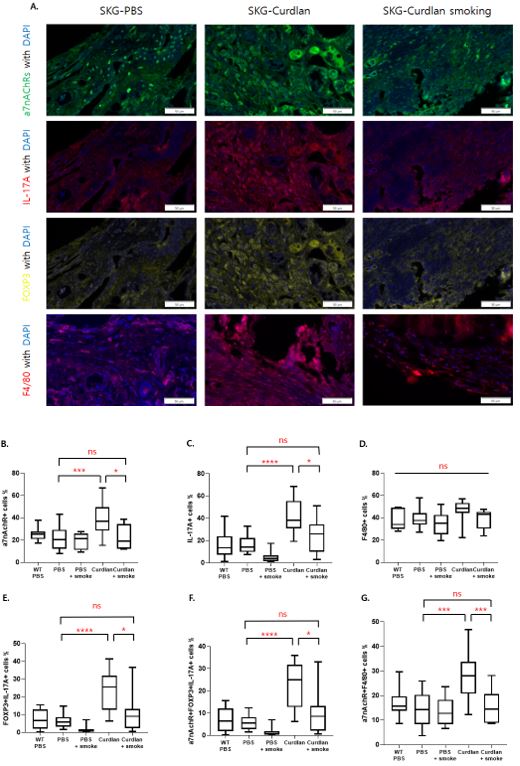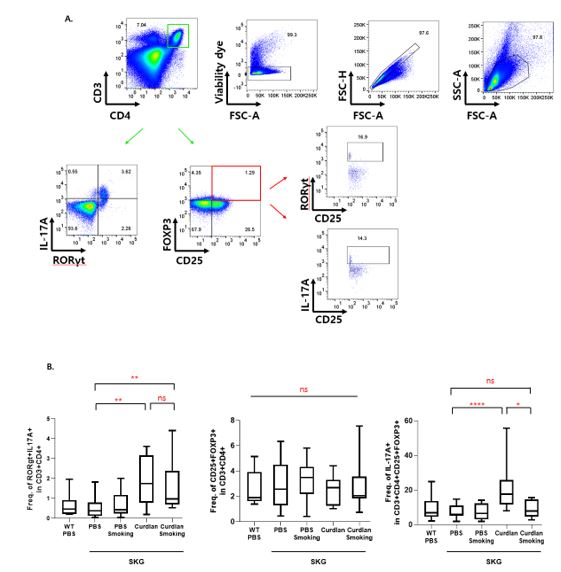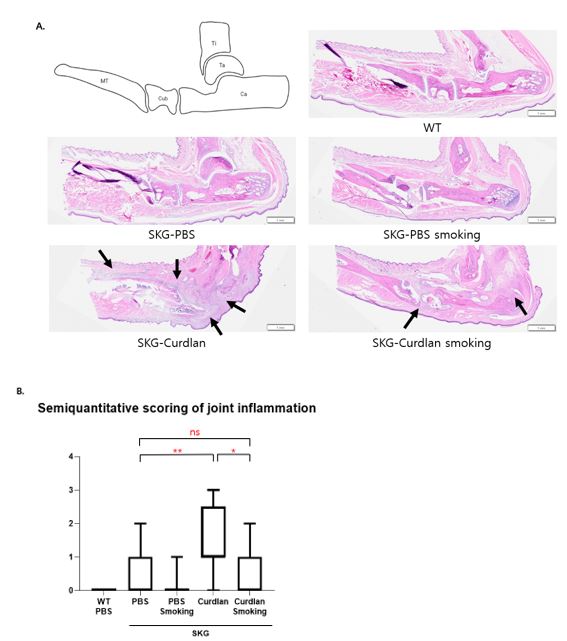Back
Poster Session B
Spondyloarthritis (SpA) including psoriatic arthritis (PsA)
Session: (1004–1034) Spondyloarthritis Including PsA – Diagnosis, Manifestations, and Outcomes Poster II
1032: Anti-arthritogenic Effect of Smoking in Curdlan-Administered SKG Mice
Sunday, November 13, 2022
9:00 AM – 10:30 AM Eastern Time
Location: Virtual Poster Hall
- YK
YoungEun Kim, MD
Department of Rheumatology, Asan Medical Center, University of Ulsan College of Medicine, Seoul, Republic of Korea
Seoul, South Korea
Abstract Poster Presenter(s)
YoungEun Kim1, Eun-Ju Lee1, Jae-Hyun Lee1, Soo Min Ahn1, Ji Seon Oh2, Seokchan Hong1, Chang Keun Lee1, Bin Yoo1 and Yong Gil Kim1, 1Department of Rheumatology, Asan Medical Center, University of Ulsan College of Medicine, Seoul, Republic of Korea, Seoul, Republic of Korea, 2Department of Information Medicine, Big Data Research Center, Asan Medical Center, Seoul, Republic of Korea
Background/Purpose: Alpha7 nicotinic acetylcholine receptor (α7nAChR), a member of AChR expressed in various immune cells and synoviocytes, has an important role in the anti-inflammatory pathway by downregulating proinflammatory cytokines. There has been growing evidence that nicotine has an anti-inflammatory property in autoimmune arthritis by activating α7nAChR on TH17 cells. However, not much is known about the effect of α7nAChR stimulation in spondyloarthropathy (SpA). We aimed to investigate the effect of cotinine, the metabolites of nicotine with long half-lives, on peripheral arthritis and spinal ankylosis in curdlan-administered SKG mice, murine models of spondyloarthropathy.
Methods: 8-week-old SKG mice were divided into the curdlan group (with or without smoking) and the PBS group (with or without smoking). In the curdlan group, curdlan was injected two times at 2-week intervals. Mice with smoking in both groups inhaled the cigarette smoke (4 cigarettes per 15 min and rest 10 min repeat) five days a week for 20-weeks since the first curdlan injection. The serum concentration of cotinine was measured at 16-week post-curdlan injection. The clinical scores for peripheral arthritis were evaluated every week. At 23 weeks, all mice were sacrificed, and splenocytes were examined for auto-reactive T cells population by flow cytometry. Immunohistochemical stains were performed for the auto-reactive T cells population. All α7nAChR expression in TH17 cells was detected using flow cytometry. To identify the presence of osteoblastic activity in the spine, imaging was performed using the fluorescent in vivo bisphosphonate agent at 21-week post-curdlan injection.
Results: At 23-week post-curdlan injection, increased α7nAChRs+ and α7nAChRs+F4/80+ cells were detected in synovia of curdlan-administered SKG mice. Metabolomics analysis at 16-week post-curdlan injection, level of cotinine was increased in smoked mice. Peripheral arthritis score was better in the curdlan group with smoking than the curdlan group without smoking. Similarly, synovial inflammation was scored lower in curdlan-administered SKG mice with smoking than those without smoking on the histologic examination. However, osteoblastic activities on the spine were not different between groups measured by fluorescence of hydroxyapatite. In flow cytometry analysis, TH17 and Treg populations were not different between groups, however, the IL-17A+ Treg population was decreased in curdlan-administered SKG mice with smoking. Furthermore, the percent of IL-17A+ cells, FOXP3+ cells, and IL-17A+FOXP3+ cells was decreased in synovia of curdlan-administered SKG mice with smoking compared with those without smoking.
Conclusion: This is the first experiment suggesting that cigarette smoking ameliorates peripheral arthritis in curdlan-administered SKG mice, with abundant α7nAChRs+ cells present in the synovia. Therefore, cotinine may play a potential role in alleviating peripheral arthritis in mice.
 Figure 3. Opal multiplexed immunofluorescent images and semi-quantitation. (A) Opal multiplexed immunofluorescent images that show the α7nAChRs+ cells, IL-17A+ cells, FOXP3+ cells and F4/80+ cells in the hind tissue. (B) α7nAChRs+ cells. (C) IL-17A+ cells. (D) F4/80+ cells. (E) FOXP3+IL17A+ cells. (F) α7nAChRs+ FOXP3+IL17A+ cells. (G) α7nAChRs+F4/80+ cells. Cigarette smoke affects immune cell population in the hind of SKG mice. *p ≤ 0.05, ***p ≤ 0.001, ****p ≤ 0.0001.
Figure 3. Opal multiplexed immunofluorescent images and semi-quantitation. (A) Opal multiplexed immunofluorescent images that show the α7nAChRs+ cells, IL-17A+ cells, FOXP3+ cells and F4/80+ cells in the hind tissue. (B) α7nAChRs+ cells. (C) IL-17A+ cells. (D) F4/80+ cells. (E) FOXP3+IL17A+ cells. (F) α7nAChRs+ FOXP3+IL17A+ cells. (G) α7nAChRs+F4/80+ cells. Cigarette smoke affects immune cell population in the hind of SKG mice. *p ≤ 0.05, ***p ≤ 0.001, ****p ≤ 0.0001.
 Figure 4. Flow cytometry of splenocyte in the mice. (A) Flow cytometry strategy. (B) Proportion of TH17 (IL-17A+RORγt+ in CD3+CD4+ cells), Treg (CD25+FOXP3+ in CD3+CD4+ cells), IL-17A+ Treg (IL-17A+FOXP3+CD25+ in CD3+CD4+ cells). *p ≤ 0.05, **p ≤ 0.01, ****p ≤ 0.0001.
Figure 4. Flow cytometry of splenocyte in the mice. (A) Flow cytometry strategy. (B) Proportion of TH17 (IL-17A+RORγt+ in CD3+CD4+ cells), Treg (CD25+FOXP3+ in CD3+CD4+ cells), IL-17A+ Treg (IL-17A+FOXP3+CD25+ in CD3+CD4+ cells). *p ≤ 0.05, **p ≤ 0.01, ****p ≤ 0.0001.
 Histologic examination of the hind from SKG mice at 22 weeks after a curdlan injection with/without cigarette smoking (A) The representative magnified images of H&E staining of all groups. Original magnification is 200x. (B) Semiquantitative scoring of joint inflammation. Curdlan-administered SKG mice without cigarette smoke have bandy leg and most severe inflammation. Curdlan-administered SKG mice with cigarette smoke also have inflammation, but it is less severe. The arrows indicate the inflammatory infiltrated cells. Ca, calcaneus; Cub, cuboid; MT, metatarsal; Ta, talus; Ti, tibia. *p ≤ 0.05, **p ≤ 0.01.
Histologic examination of the hind from SKG mice at 22 weeks after a curdlan injection with/without cigarette smoking (A) The representative magnified images of H&E staining of all groups. Original magnification is 200x. (B) Semiquantitative scoring of joint inflammation. Curdlan-administered SKG mice without cigarette smoke have bandy leg and most severe inflammation. Curdlan-administered SKG mice with cigarette smoke also have inflammation, but it is less severe. The arrows indicate the inflammatory infiltrated cells. Ca, calcaneus; Cub, cuboid; MT, metatarsal; Ta, talus; Ti, tibia. *p ≤ 0.05, **p ≤ 0.01.
Disclosures: Y. Kim, None; E. Lee, None; J. Lee, None; S. Ahn, None; J. Oh, None; S. Hong, None; C. Lee, None; B. Yoo, None; Y. Kim, None.
Background/Purpose: Alpha7 nicotinic acetylcholine receptor (α7nAChR), a member of AChR expressed in various immune cells and synoviocytes, has an important role in the anti-inflammatory pathway by downregulating proinflammatory cytokines. There has been growing evidence that nicotine has an anti-inflammatory property in autoimmune arthritis by activating α7nAChR on TH17 cells. However, not much is known about the effect of α7nAChR stimulation in spondyloarthropathy (SpA). We aimed to investigate the effect of cotinine, the metabolites of nicotine with long half-lives, on peripheral arthritis and spinal ankylosis in curdlan-administered SKG mice, murine models of spondyloarthropathy.
Methods: 8-week-old SKG mice were divided into the curdlan group (with or without smoking) and the PBS group (with or without smoking). In the curdlan group, curdlan was injected two times at 2-week intervals. Mice with smoking in both groups inhaled the cigarette smoke (4 cigarettes per 15 min and rest 10 min repeat) five days a week for 20-weeks since the first curdlan injection. The serum concentration of cotinine was measured at 16-week post-curdlan injection. The clinical scores for peripheral arthritis were evaluated every week. At 23 weeks, all mice were sacrificed, and splenocytes were examined for auto-reactive T cells population by flow cytometry. Immunohistochemical stains were performed for the auto-reactive T cells population. All α7nAChR expression in TH17 cells was detected using flow cytometry. To identify the presence of osteoblastic activity in the spine, imaging was performed using the fluorescent in vivo bisphosphonate agent at 21-week post-curdlan injection.
Results: At 23-week post-curdlan injection, increased α7nAChRs+ and α7nAChRs+F4/80+ cells were detected in synovia of curdlan-administered SKG mice. Metabolomics analysis at 16-week post-curdlan injection, level of cotinine was increased in smoked mice. Peripheral arthritis score was better in the curdlan group with smoking than the curdlan group without smoking. Similarly, synovial inflammation was scored lower in curdlan-administered SKG mice with smoking than those without smoking on the histologic examination. However, osteoblastic activities on the spine were not different between groups measured by fluorescence of hydroxyapatite. In flow cytometry analysis, TH17 and Treg populations were not different between groups, however, the IL-17A+ Treg population was decreased in curdlan-administered SKG mice with smoking. Furthermore, the percent of IL-17A+ cells, FOXP3+ cells, and IL-17A+FOXP3+ cells was decreased in synovia of curdlan-administered SKG mice with smoking compared with those without smoking.
Conclusion: This is the first experiment suggesting that cigarette smoking ameliorates peripheral arthritis in curdlan-administered SKG mice, with abundant α7nAChRs+ cells present in the synovia. Therefore, cotinine may play a potential role in alleviating peripheral arthritis in mice.
 Figure 3. Opal multiplexed immunofluorescent images and semi-quantitation. (A) Opal multiplexed immunofluorescent images that show the α7nAChRs+ cells, IL-17A+ cells, FOXP3+ cells and F4/80+ cells in the hind tissue. (B) α7nAChRs+ cells. (C) IL-17A+ cells. (D) F4/80+ cells. (E) FOXP3+IL17A+ cells. (F) α7nAChRs+ FOXP3+IL17A+ cells. (G) α7nAChRs+F4/80+ cells. Cigarette smoke affects immune cell population in the hind of SKG mice. *p ≤ 0.05, ***p ≤ 0.001, ****p ≤ 0.0001.
Figure 3. Opal multiplexed immunofluorescent images and semi-quantitation. (A) Opal multiplexed immunofluorescent images that show the α7nAChRs+ cells, IL-17A+ cells, FOXP3+ cells and F4/80+ cells in the hind tissue. (B) α7nAChRs+ cells. (C) IL-17A+ cells. (D) F4/80+ cells. (E) FOXP3+IL17A+ cells. (F) α7nAChRs+ FOXP3+IL17A+ cells. (G) α7nAChRs+F4/80+ cells. Cigarette smoke affects immune cell population in the hind of SKG mice. *p ≤ 0.05, ***p ≤ 0.001, ****p ≤ 0.0001. Figure 4. Flow cytometry of splenocyte in the mice. (A) Flow cytometry strategy. (B) Proportion of TH17 (IL-17A+RORγt+ in CD3+CD4+ cells), Treg (CD25+FOXP3+ in CD3+CD4+ cells), IL-17A+ Treg (IL-17A+FOXP3+CD25+ in CD3+CD4+ cells). *p ≤ 0.05, **p ≤ 0.01, ****p ≤ 0.0001.
Figure 4. Flow cytometry of splenocyte in the mice. (A) Flow cytometry strategy. (B) Proportion of TH17 (IL-17A+RORγt+ in CD3+CD4+ cells), Treg (CD25+FOXP3+ in CD3+CD4+ cells), IL-17A+ Treg (IL-17A+FOXP3+CD25+ in CD3+CD4+ cells). *p ≤ 0.05, **p ≤ 0.01, ****p ≤ 0.0001. Histologic examination of the hind from SKG mice at 22 weeks after a curdlan injection with/without cigarette smoking (A) The representative magnified images of H&E staining of all groups. Original magnification is 200x. (B) Semiquantitative scoring of joint inflammation. Curdlan-administered SKG mice without cigarette smoke have bandy leg and most severe inflammation. Curdlan-administered SKG mice with cigarette smoke also have inflammation, but it is less severe. The arrows indicate the inflammatory infiltrated cells. Ca, calcaneus; Cub, cuboid; MT, metatarsal; Ta, talus; Ti, tibia. *p ≤ 0.05, **p ≤ 0.01.
Histologic examination of the hind from SKG mice at 22 weeks after a curdlan injection with/without cigarette smoking (A) The representative magnified images of H&E staining of all groups. Original magnification is 200x. (B) Semiquantitative scoring of joint inflammation. Curdlan-administered SKG mice without cigarette smoke have bandy leg and most severe inflammation. Curdlan-administered SKG mice with cigarette smoke also have inflammation, but it is less severe. The arrows indicate the inflammatory infiltrated cells. Ca, calcaneus; Cub, cuboid; MT, metatarsal; Ta, talus; Ti, tibia. *p ≤ 0.05, **p ≤ 0.01.Disclosures: Y. Kim, None; E. Lee, None; J. Lee, None; S. Ahn, None; J. Oh, None; S. Hong, None; C. Lee, None; B. Yoo, None; Y. Kim, None.

